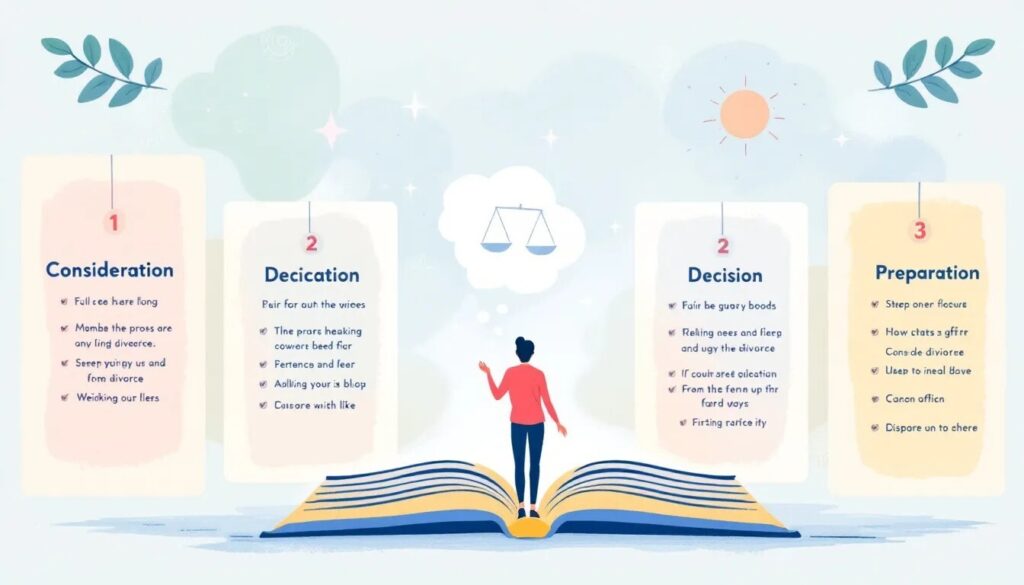
Not sure how to go about getting divorced in USA? This guide breaks down the process into clear, manageable steps from understanding legal requirements to finalizing the paperwork. While each state has its own legal laws, the process is relatively similar. For state specific information, please consult our Divorce Directory or take the complimentary self assessment to be matched with the most ideal professional for your needs. Just know while the basic steps remain consistent, the divorce laws vary significantly by state. An example is that divorce waiting periods and residency requirements differ between states like California and Texas. For state-specific details, check out our comprehensive divorce guides for each region.
Let’s navigate this challenging journey together.
Step 1:How the Divorce Process Works: Key Steps and Requirements

It is essential to understand the divorce process before starting with filing. The specifics of divorce legislation are subject to vary across different states in USA, and this impacts the procedures and prerequisites for your specific region. Familiarity with state-specific rules regarding residency and separation periods is vital in preventing needless postponements. For more specific details, see our FAQs for your state.
In a majority of states, no-fault divorces are possible, allowing partners to end their marriage without pointing fingers at each other. Some regions still acknowledge claims for at-fault divorces, which may introduce additional complexity into the procedure. Gaining knowledge about local laws and regulations related to either type of divorce is an important initial step.
Understanding these fundamental aspects prepares you for a more conscious journey through what could potentially be an overwhelming experience during your separation from your spouse. Knowledge provides crucial security as it equips you with the means to efficiently steer through the legalities involved in dissolving a marriage.
Step 2: How to Prepare for Divorce: Legal and Emotional Considerations

Embarking on a divorce journey encompasses more than the legal formalities. It’s an odyssey marked by emotional and logistical options and decisions. Committing fully to the path of closure facilitates a less turbulent experience. Embrace challenging times, develop resilience against difficult emotions, and designate periods free from divorce matters for essential respite.
Emotional Considerations During Divorce:
Building emotional stability is critical during this period. Recognizing what’s affecting you negatively, creating new boundaries and finding better ways to manage the overload of daily emotions will determine whether your divorce process is easy to manage or difficult to navigate. Beyond prioritizing self-care through proper nutrition, exercise routines, and seeking mental health support when needed, equipping yourself with a robust support via Divorce Coaching will also provide you with necessary guidance and direction to helping you move forward. For an in-depth look at how coaching compares to traditional therapy, read How a Divorce Coach Can Help You More Effectively Than Therapy.
Financial Readiness: Getting yourself a CDFA
Most people think that preparing your financial documents stands is the most important 1st task in preparing for divorce proceedings or your meeting with your lawyer. These documents could include:
- Tax returns
- Bank statements
- Credit card statements
- Mortgage documentation
- Retirement account overviews
Yet, after working with 1000s of families, we see that the common mistake made is when people get bad financial advice which can lead to costly mistakes and post divorce regret. This typically happens when they realize that they did not fully understand their overall financial situation before starting the divorce process. Understanding your financial situation before initiating divorce proceedings is crucial. Divorce can affect your income, your home, and your retirement savings, so having a comprehensive understanding of your financial standing will help you make informed decisions. Rather than going to your CPA, I recommend you seek the help of a CDFA, a divorce trained financial expert.
For those whose spouses manage their own businesses, securing detailed insights into their operations is beneficial to avoid future remorse among partners regarding financial awareness.
Employing a comprehensive ‘Divorce Preparation 101’ checklist serves as guidance through the upcoming emotional rollercoaster and fiscal complexities that lay ahead. This list might range from collecting vital monetary records to incorporating habits conducive to personal wellbeing – all aiming toward easing the forthcoming transition.
Step 3: Choosing Your Legal Advice Professional: Consulting a Divorce Attorney or Mediator
Seeking advice from a competent legal counsel erves as guidance through the upcoming emotional rollercoaster and fiscal complexities that lay ahead. This list might range from collecting vital monetary records to incorporating habits conducive to personal wellbeing – all aiming toward easing the forthcoming transition.
At an early stage of the divorce process, it’s important to choose between going to court or engaging in mediation. While litigation might be prolonged and emotionally taxing, mediation provides a more cooperative solution. Too many people later lament not seeking professional guidance but instead relying on informal suggestions from platforms like social media. Thoroughly vetting the expertise and standing of your attorney ensures they’re suitable for handling your particular situation. Irooze can help you with this process.
A seasoned Legal Consultant is a 3rd alternative option for those going Pro Se- representing yourself. They can offer clarity regarding laws and documentation required in your specific state. We understand the appeal to DIYing your divorce – yet, we wanted t o point out that this level of specialized advice is valuable when it comes to making knowledgeable choices and steering clear of expensive errors or unnecessary delays.
Step 4: How to Serve Divorce Papers: Everything You Need to Know

After deciding to divorce, the next step is serving divorce papers. This legal procedure officially notifies your spouse about the divorce proceedings. Methods include hand-delivery, certified mail with a return receipt, or regular mail with a written acknowledgment from the spouse. Read the FAQs in your state for more accurate details.
Proper service ensures the divorce process moves forward without unnecessary delays. It also prevents your spouse from claiming they were unaware of the proceedings.
Step 5: What to Do After Receiving Divorce Papers: How to Respond to a Divorce Petition
Upon receiving the divorce papers, it is imperative for the respondent to take swift action. If a response is not filed within 30 days, the petitioner may pursue a default judgment. This would give the court authority to make determinations in the absence of the respondent’s involvement. By submitting a response within this timeframe, one can ensure their active role in the legal process.
The individual has an allowance of 60 days from when they file their divorce case to serve these papers. Failing which, one must seek an extension so as not to have their case dismissed by the court. How promptly and accurately you respond can significantly affect your divorce proceedings’ final decisions.
Step 6: How to Negotiate a Divorce Settlement: Tips for Avoiding Court
The most taxing aspect of a divorce often lies in negotiating settlements. By centering on fairness over triumph, the process can become more efficient and inflict less emotional pain. A case in point involved Sarah and Mark who, during their marriage dissolution, chose to prioritize financial stability and adopt a responsible co-parenting relationship for the sake of their children’s well-being. They documented these priorities, which helped them manage expenses related to their settlement and finances effectively. Despite any hurt feelings that arose throughout this period, they committed to an agreement that upheld respect among themselves by maintaining transparent communication.
Legal representatives play a pivotal role as intermediaries during negotiations. They not only facilitate discourse between parties, but also strive for peaceful resolutions through mediation tactics. Their involvement helps ensure decisions are grounded in fact rather than swayed by raw emotion—keeping the focus objective—which is especially evident with methodologies like collaborative divorce or other forms of mediation designed for reaching consensus while keeping hostilities at bay.
Should such methods of alternative dispute resolution prove unsuccessful, individuals still retain the option to seek intervention from a court—a route offering several alternatives towards securing an equitable divisional outcome when navigating divorce proceedings.
Step 7:How to Request Temporary Orders in a Divorce
During the divorce process, urgent concerns such as financial assistance and child custody are regulated by temporary court orders. To address crucial issues before finalizing the divorce, judges issue a court order.
To start a temporary order, you must submit certain documents to the court, which include a petition along with a supporting declaration. The judge assesses the presented evidence in the hearing and then decides whether to grant or alter a temporary order. These orders provide stability and clear guidance throughout the divorce process. Your family law attorney will provide you with more accurate state specific details.
Step 8: What to Expect at a Divorce Hearing: How to Prepare for Your Court Date
The commencement of a divorce hearing marks a pivotal stage in the proceedings. As the trial unfolds, each person involved has an opportunity to present their perspective, beginning with the petitioner—the one who initiated the divorce process. After considering arguments from both parties, a judge will make a determination. This decision does not immediately bring about the conclusion of the divorce. The initiation of such proceedings triggers an intricate sequence of legal formalities.
In court, witnesses may take to stand and offer testimonies which are then scrutinized through cross-examination by those representing opposite interests. When introducing evidence into court records, it is incumbent upon its presenter to validate its relevance and authenticity via witness statements. Both sides retain rights to challenge any perceived breaches regarding rules governing how evidence should be presented—a procedure that often entails Examination or clarification surrounding submitted proofs for a more comprehensive understanding.
Anticipating what lies ahead during your day in court can significantly enhance one’s preparedness when arguing their case before a judge. This anticipation provides key information that could prove invaluable as you navigate through each phase leading up to resolution within these legal confines.
Step 9: How to Finalizing the Divorce Legal Process

The final phase involves securing a divorce decree, which not only formally dissolves the marriage but also sets forth the conditions for distributing assets, spousal support, and child custody arrangements. A checklist to be followed after the divorce is crucial in confirming that all essential actions have been taken to avoid potential legal complications in the future.
After you finalize your divorce, it’s important to finalize your financial circumstances, handle the QDRO and life insurance policies, put into effect your new budget plan, and close up any shared accounts. It’s equally vital to update critical personal documents like IDs and insurance policies so they accurately represent your current marital status.
Co-parenting
For parents who must continue co-parenting after divorce, maintaining open lines of communication along with implementing a well-organized parenting strategy is imperative for fostering their children’s welfare. Undertaking these measures lays down solid groundwork both for embarking on life as another parent and managing effective parenting time. Check out our library of free resources to learn more tips and strategies on coparenting during and after your divorce.
Focus on YOU
Following a divorce, individuals often experience an opportunity for self-improvement and embarking on fresh endeavors. It’s vital to prioritize emotional health by indulging in activities that promote personal care and potentially seeking guidance from therapists. The presence of a supportive network composed of family, friends, or groups dedicated to offering assistance is indispensable during this period of change.
Many people overlook the importance of preparing for their post-divorce existence, concentrating solely on immediate concerns and letting go. It is beneficial to explore new passions and establish individual objectives as one progresses into this next phase.

